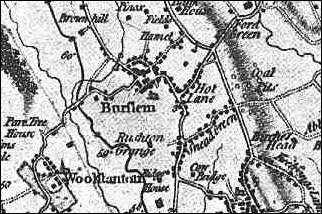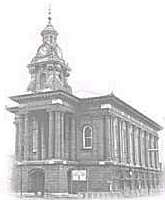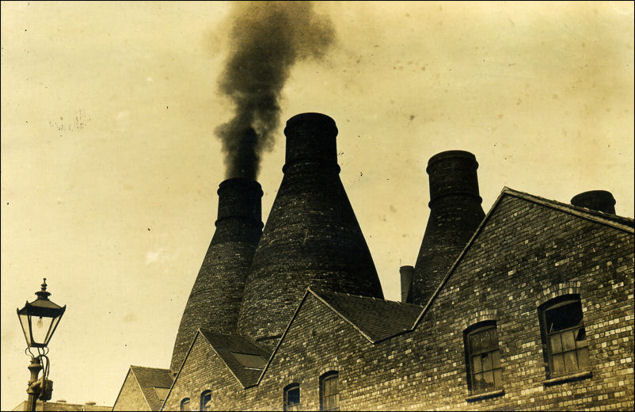Burslem,
an ancient town.... the mother, as it is the metropolis, of the
Staffordshire Potteries.
BURSLEM, a town, a township, a
parish, and a subdistrict in the district of Wolstanton, and
within the borough of Stoke-upon-Trent, Staffordshire. The town
stands on the side of a hill, adjacent to the Grand Trunk canal
and the North Stafford railway, 3 miles NNE of
Newcastle-under-Lyne.
To Burslem belongs the proud
title of the "mother of the potteries." As early as
the 17th century this town was noted above all others for the
production of the best classes of pottery made in this country.
Here, too, was born the greatest exponent of the potters' art
whom the world has known - Josiah Wedgwood - who was born at
Burslem in July, 1730
Burslem is a populous and well
built market town, and holds a healthy and elevated situation in
the northern division of that extensive and celebrated seat of
the china and earthenware manufactures, being seated between
Hanley and Tunstall.
John Wesley frequently visited
Burslem.
|
Lord of the
Manor Walter Sneyd, Esq. of Keel,
was
lord of the manor.
"BURSLEM, an ancient
town, with a market held for a long period by custom, and subsequently
sanctioned by an act of parliament, is about three miles from
Newcastle and two from Hanley, entitled to the precedence of other towns
in this district, as claiming to be the mother, as it is the metropolis,
of the Staffordshire Potteries."
1828 journal
"In the Doomsday
Survey - for even in that early date Burslem was a place of some
importance - the town appears, as "Burwardeslyn;" and
frequent mention is made of it in ancient documents during the Middle
Ages."
1893 journal
Dates in the
history of Burslem
1448 - Richard
Adams and his brother William were fined for 'digging clay by
the road' between Burslem and Sneyd.
1563 - Thomas Adams of Burslem left his 'best yron
chymney' to his son William and his other chimney to his
daughter Ellen.
1662 - Act of Parliament called upon Burslem
butter-pot makers to to restrict the weight of the pots to about
six pounds, to that a twenty-pound load could contain a stone of
butter.
1748 - The burial of the so-called 'Burslem Witch'
Margaret Leigh (Peggy Lee).
1759 - Josiah Wedgwood I rented the Ivy House Pottery
Works, Burslem, from his uncles John and Thomas Wedgwood.
1764 - Josiah Wedgwood I transferred his rapidly
expanding business from Ivy House Works to the Brick House Works
(also known as the Bell Works) in Church Street, Burslem.
1761 - Burslem's first Town Hall Built.
1801 - Burslem's population: 6,578
1817 - Waterloo Road from Burslem, through Cobridge to
Hanley finished, named after the famous battle of 1815.
1854 - A new Town Hall built in Burslem's Market Square
on the site of the original 1761 Town Hall. Completed in 1857
and designed by G. T. Robinson.
1860's - Parkers Brewery founded.
1871 - Burslem created a borough.
1911 - Burslem's third Town Hall completed. It houses the
Queen's Theatre. Designed by Russel & Cooper of London.
1958 - Burslem's old Meat Market demolished.
 Dates in the
history of Stoke-on-Trent
Dates in the
history of Stoke-on-Trent
|
Facts about
Burslem from old journals
Burslem is the place where the
first clod of that great national undertaking the Trent and
Mersey canal, was cut, by the late Josiah Wedgwood, Esq.
The town is pleasantly situate on a rising ground, and contains
many admirably arranged manufactories, numerous dwellings for
the workmen employed therein, many good houses for the
superintendents of the works, and some handsome edifices for the
proprietors
 |
|
"Walks"
and articles on Burslem
and the surrounding area |
 Burslem: The
Wedgwood Family & Enoch Wood
Burslem: The
Wedgwood Family & Enoch Wood
The changes in the town from George I to accession of Queen
Victoria (1714-1837).
|
|
 Packhorse
Lane
Packhorse
Lane
Burslem - 'Packhorse Lane - the lifeline of the Potteries'
|
 Packhorse & Turnpikes
Packhorse & Turnpikes
The eighteenth century saw the development of the North
Staffordshire pottery industry from a cottage industry to a major
exporting industry.
The connection was the packhorse road from the Fountain Place
works of Enoch Wood in Burslem, though Longbridge (now Longport)
and onto to Newcastle. |
 Longport:
John Davenport & Longport
Longport:
John Davenport & Longport
The creation of Longport (by the Trent & Mersey canal)
between 1760-mid 19thC.
|
 Middleport:
Burgess & Leigh - the 'Model' Victorian Potworks
Middleport:
Burgess & Leigh - the 'Model' Victorian Potworks
A tour of a working Victorian potworks - opened in 1888, famous
world over for Burleigh ware. A listed building and rescued from
the receiver in 1999.
|
 Trubshaw
Trubshaw
'Major gateway provides a glimpse into cities past'
|
 Trubshaw
Cross in detail
Trubshaw
Cross in detail
Trubshaw Cross is the upper part of Longport, situated on the
junction of Newcastle Street and Davenport Road - it was an
important point on the packhorse lanes from Newcastle-under-Lyme
to Burslem and Tunstall.
|
 Cobridge:
A Victorian Suburb Cobridge:
A Victorian Suburb
Rushton Grange, the development of Cobridge as a community, the
churches and potworks - also the home of the novelist Arnold
Bennett.
|
 Cobridge
'the changing face of Cobridge'
Cobridge
'the changing face of Cobridge'
|
 Cobridge
'the Victorian suburb en-route to Burslem'
Cobridge
'the Victorian suburb en-route to Burslem'
|
 Cobridge
in detail The Road from Hanley to Burslem
Cobridge
in detail The Road from Hanley to Burslem
|
 Bournes
Bank in detail Bournes
Bank in detail
Bournes Bank was originally named 'Church Street' as it was the
main route from Burslem to the parish church of St. John.
Waterloo Road was not built until 1817 and originally Bournes
Bank was also the road travelled to get to Hanley. |
 Dalehall
in detail
Dalehall
in detail
Dalehall - a district of Burslem, arranged either side of
Newcastle Street. Nowadays Dalehall, although preceding it in
antiquity has been subsumed into the general area known as
Middleport.
The Burslem family were living at Burslem by the end of the 13th
century. By the end of the 16th century their Burslem house was
Dale Hall.
|
 Hulton
Abbey to Ruston Grange
Hulton
Abbey to Ruston Grange
This walk examines Hulton Abbey, the trackway along Sneyd Street
and the monks farmland at Ruston Grange.
|
 A
walk around Burslem Cemetery
A
walk around Burslem Cemetery
Burslem Cemetery opened in 1879 and covers approximately 11.4
hectares (about 28 acres) when it was opened it was intended to
be a "a recreation park, to be used
for walking, riding and driving" as well as a cemetery and
at least a third of the land was taken up with the lodges,
chapel, walks & drives. Only about five and a half acres was
laid out for burials. |
Old Roads 'walks' around
Burslem area:-
| Bournes
Bank | Dale
Hall
|
| Burslem
Cemetery
|
A walk along the Potteries Loop
Line :-
Burslem
on the loop line
Burslem
in depth
On the loop line between Tunstall and Hanley were the stations
at Burslem and Cobridge. Both of these stations were alongside
or in the respective parks.
On Thursday, July 21st, 1870, the ceremony of the cutting of the
first sod took place in a very unostentatious manner at Burslem.
Cobridge
in depth
In Bennett's novel Cobridge was referred to as
"Bleakridge"
The introduction of steam trams and then in 1873 the opening of
the Loop Line with a station at Cobridge made the area
accessible and it became a desirable residential area "It
had also been predicted that even Hanbridge [Hanley] men would
come to live at Bleakridge [Cobridge] now." |
|

Burslem from W. Yates'
A Map of
the County of Stafford, 1775
- click for bigger map -
 maps on
Burslem
maps on
Burslem |
|

Burslem Town Hall
Burslem has
had three Town Halls The original was built as early as 1761.
There are still two standing.
 on
Burslem's Town Halls
on
Burslem's Town Halls
|

